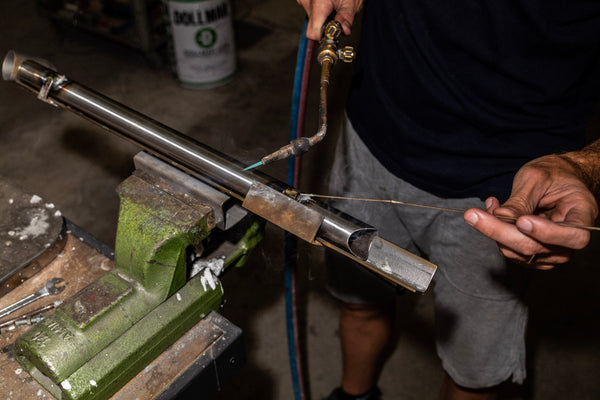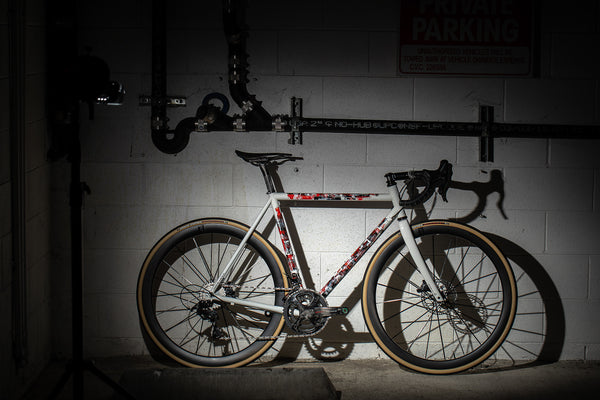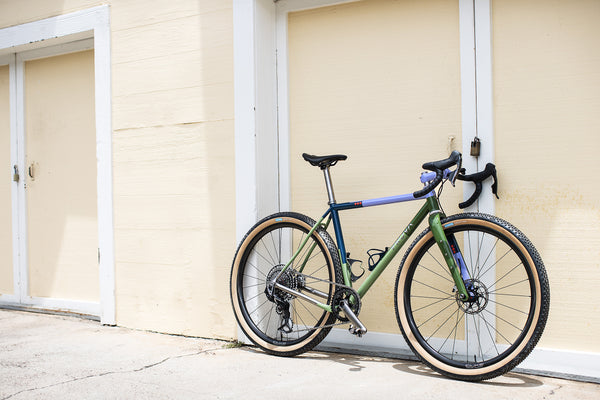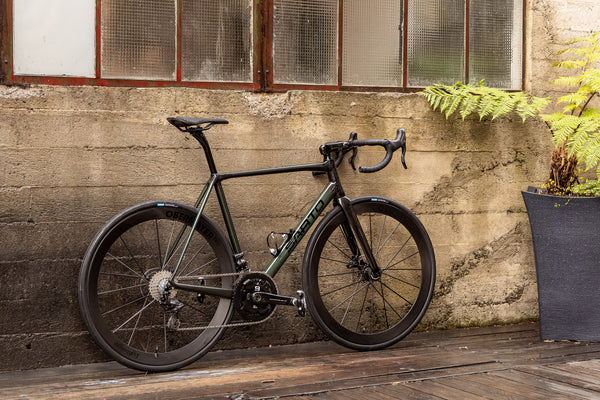In this week’s installment of AC Tech Talks, we’re looking at drivetrains. We’re going to forget about brands (at least for now) and not really concern ourselves with the number of speeds, but rather focus in on the fundamental approach to how they work—derailleurs moved by a mechanical cable or those that pan the gears by way of electronic motors. Yep, mechanical vs. electronic shifting. Get cozy, pour yourself a nice glass of whiskey (or milk if booze aint your thing) and let’s get into the discussion.
In case you missed it, check out our previous Tech Talk on tires here.
Okay, we’ll come out swinging with the big question first. Is there any performance benefit to electronics or is all just an excuse to spend more dough?
Robert: Yes & no. Life is all about give & take. Everything has a pro & a con. If you ask a pro cyclist this question they will ALWAYS say “yes..” this is the “correct” drive chain & control lever set up you should ride because this is their sponsor. Depending on who you are... If you ask a mechanic behind closed doors they will sometimes give you an honest answer of common pros and cons of their riders' experience on X, Y, & Z components.
The term “pay to play” is a very accurate saying in my opinion. The goal of each component brand is to sell as much as possible, but to also keep in mind that there are different category levels of cyclist on the market. The entry level electronic components on the market tend to be a bit heavier in weight & more bulky, with less precession on ergonomics & finished aesthetic.
In my opinion the performance benefit with an electronic drive train is found with the ease of pressing a small button to actuate a derailleur vs throwing a shift lever with more hand motion to get a cable to pull. Electronic shifters also have beneficial options of where you can become creative in the placement of said electronic remote buttons vs mechanical you’re more or less stuck with the simple lever throw to pull a cable. BikeRumor did a little write up a while back with my old roommate Tyler Marchesano and his creativity on installing a Di2 sprint cable with PlayStation controller buttons.
In general as a mechanic, servicing electronic drivetrains we will typically “set it & forget it”. I was an attendee at the 2014 Bill Woodul Race Mechanic clinic at the Colorado Springs Olympic Training center & the “Electronic Shifting” course was very simple back then. Step 1: Check to see if the battery is plugged in & Step 2: Charge the battery. This is generally the gist of standard maintenance for electronic shifting on the consumer & cyclist side of things.
There’s a grey area of electronic drivetrains and bike washing - we will get to bike washing and bike care on a later journal. At the end of the day I’d say electronic shifting is just a different flavor preference with different pro’s and con’s than a mechanical drivetrain.

Derek: Hmm, that’s a bit tricky to answer. For general riding I’d say no, it’s not like electronic shifting is magically going to make you a stronger rider. That said, there are a few areas where, at least to a racer, I think it can make a difference.
One, if you’re riding in poor weather and excess dirt or debris is getting kicked onto the bike, a traditional shift cable might get gritty and jammed up, causing shifting issues that could make or break your ride. It’s definitely happened to me on multiple occasions. Typically, electronic derailleurs don’t suffer from that, and can keep on working with speed and precision, even as the gunk builds up. As a gravel and cyclocross racer, I can say that I’ve been absolutely blown away at how well a Di2 derailleur can keep working when totally coated in mud.
Another factor is the ability to run remote buttons and have customization over all of their functions. This can make it easier to keep shifting even when, say, you’re taking a drink of water and only have one hand on the bike. While not really a big deal, those small instances of shifting efficiency can be the difference in sticking with a break or not in a race.
Chad: Keeping this one simple as Robert went so deep. No, I do not think anyone will go faster with an electronic drivetrain instead of a mechanical one. As long as both are set up correctly. It doesn’t make you stronger, it doesn’t make the bike lighter and it doesn’t add watts.
Depending on who you are, electronic shifting may be more trick, may look cooler, may shift better for how you ride, but I don’t see it making you go faster.

What do you remember thinking the first time put in miles on a bike with electronic shifting?
Robert: Haha - A first experience was on a customer's Di2 equipped bike around the Land Park area in Sacramento by the shop I used to work at. My vague memory was thinking that this is the future and this will only get better. There was the “cool” factor to having that experience of checking out the “latest” and “greatest,” but I do remember the electronic shifting feeling a bit slower in comparison to the mechanical. Early generation of Di2 External battery & cable routing was not appealing to me. Then again I say “meh” to a lot of things. It takes a lot to impress me, but from a mechanics standpoint I’d say I’ve always preferred a mechanical shifting bike as opposed to electronic.
When I first jumped into the cycling industry I was seeing the tail end of Mavic’s attempt at electronic shifting. I always thought the idea was good, but Mavic definitely jumped the gun on this and never followed up with anything after their early attempts.
Derek: My first experience with Di2 was upgrading a client's bike when it first came out. It took a while to get all set up, but once up and running, it was immediately impressed by the smoothness and the light action of the shift buttons. At that time, frames weren't designed for the e-tube cable routing, so the wires were literally taped down the outside of the frame. That was a really hideous look.
It took a while before I actually owned a bike myself with electronic shifting. It was a Focus Izalco with Campagnolo Record EPS. When it worked, I remember being absolutely amazed at how smooth and elegant the shifts felt. The problem was it would never work for very long. The system would constantly malfunction, and it got to a point where I learned how to reboot and fine tune the shifting all while rolling mid ride. Luckily, my experiences have been much more reliable on my bikes since then.
Chad: I rode one of the first Di2 bikes many years ago. Pinarello had a fleet of bikes with the new Shimano group set up for their grand fondo. First thing I remember was the sound it made. It was cool at first because it was different, but over time I prefer a more silent bike. To its credit, I was pretty amazed at how well it shifted. Right after that I got a Baum Corretto bike set up with the new group and it was great, though the rear derailleur malfunctioned after a few hundred miles and that kind of blew. Especially Because it took us a few hours to figure out what the issue was. I also didn’t like the aesthetics of the derailleurs, not to mention the external routing. The derailleurs were so much bigger and didn’t look anywhere near as nice as the mechanical version. That alone kept me on mechanical for a while.

Does electronic address any issues that mechanical has left lacking?
Robert: Electronic shifting has addressed the issue of sheared cable heads in the shifter. As we progress with technology, I think more and more frame brands will be putting cables, wires, and batteries inside the bike frames to be more “aero” and to have a cleaner aesthetic... Electronic wires address the issue of shift cables being crossed in a down tube or in general, issues that arise from friction or worn out cable housing on a traditional mechanical shifting bike. With that being said, I have seen electronic wires go bad too. Kinked wires or wires that have had abrasive contact with something can totally send incorrect singles to the drivetrain causing a battery to drain itself.
When you really look inside a naked bike frame the edges on some of the tubes can be extremely sharp, so I typically never try to force an electronic wire inside an internally routed bike frame or handlebar. Internally routed bikes are the future and we need to be cautious as mechanics when first installing these electronic wires as the can totally kink or shear.
Derek: One thing, is that there are no cables to stretch and wear, or housing to build up contamination and friction. As long as the bike is set up properly, the shifting really doesn’t go out of tune the way mechanical systems do. Even as the chain and cogs wear out, electronic systems seem to just keep on shifting with solid performance. Those are nice perks, but I wouldn’t necessarily say that leaves the mechanical drivetrain lacking.
Another point is options for remote and customizable shift points. Again, this is a luxury and by no means a necessity, but it’s amazing how quickly you can become attached to having shift access at various points on the handlebar, or even simply the three programmable buttons on each standard Di2 lever.

One last thing I’ll note is that electronic drivetrains have enabled more possibilities for mixing and matching pieces from road and mountain. Obviously, this is more specific to dirt and touring style bikes, but we’re no longer limited by the unique cable pull ratios that have always separated mechanical road and mountain systems. Drop bar levers with mtb cassettes was really a major advancements for gravel bikes.
Chad: Yes, especially on TT/Tri bikes and any other internally routed frame. Mechanical works best when routed externally, but since so many stock frames come set up for internal shifting, it’s pretty much forced our hand to using electronic drivetrains if you want the best possible shifting.

Has one system proven to be more durable or reliable than the other?
Robert: Mechanical takes my vote every time in terms of durability. My thoughts—Less moving parts = more durable.
Derek: Well, as I mentioned before, my first bike with gen 1 Campagnolo EPS was highly unreliable. Aside from that though, I’d say no. Aside from that bike, I’ve never had a reliability or durability issue that was due to the part being mechanical or electronic.
Chad: I’ve had good luck with both. Mechanical shifting does take a little more tinkering, but I like that and it’s super easy. But when both are set I find that they hold that set up really well. However, I will say that this is not what I see from a lot of peoples’ bikes that come through the door. You have to be more careful with an electronically set up bike. I’ve seen tons of sheared off wires, batteries that are damaged and poor setup that can affect the lifetime of the parts. I see this a little less with mechanical, but maybe that’s because there are less mechanical groups out there now?
Have you ever been out on a ride while on a bike with mechanical shifting and had something happen that left you thinking “Dammit, this wouldn’t have happened on an electronic drivetrain bike!”
Robert: No, I don’t ride enough. Per our last conversation in the tubular,tube, & tubeless tech talk.
Derek: On more than one occasion, I’ve had the head of a shift cable snap off inside the shifter. Jesus Christ is that a pain in the ass. Not only losing shifting mid ride, but the laborious task of later getting the head out of its cradle. Of course there’s also just general cable wear.I've definitely been on rides in the wet/mud where the cable housing has just gotten too contaminated to function anymore.

Chad: Actually, I have not. I’ve never had a cable break and I keep my bike in good enough tune that the shifting is always smooth. The issues I’ve had would have been the same on either electronic or mechanical drivetrains. Actually, scratch that, I do get the initial cable stretch break in period with my mechanical groups, but that's about it.
What about the reverse situation?
Robert: Yes! I’ve had a battery die on me mid ride. Granted, I love that Sram has made the batteries compatible on both derailleurs, I did not like losing one derailleur function on my ride. This issue was entirely my fault for going on the Three Bears ride solo without a spare battery, but this is a huge benefit for mechanical shifting bikes. You really don’t need to think about charging your bike on mechanical shifting bikes. You can travel for months on end and return to your mechanical shifting bike and not think about anything and just get up and go whereas on electronic shifting bikes you will need to take a couple extra steps to charging your drive chain. Sram & Shimano have made their charging features quite easy whereas Campagnolo takes a little more precision to get that EPS charger in.
Derek: Yes, every time I’ve geared up to meet people for a ride, only to realize my bike had a dead battery, ha. Obviously, that comes down to user error, but I do find that to be a ridiculous reality and overcomplication of the bicycle.
Of course, there were the random malfunctions I mentioned before on my first EPS bike.
I once was working on my bike and severed a e-tube while putting the seatpost back into my bike. That turned into a huge, unnecessary project of pulling the cranks and bb out to access the junction box and replace the wire.
Chad: Not really here either. Mainly just the stress of hoping there was enough juice in the batteries for the ride I had coming up. If you take care of your equipment I find that you’ll have less surprises on the road, regardless of the type of shifting system you use.
Initial set up/bike build aside, is there a stand out pitfall to going electronic?
Robert: Pitfall = Dead batteries & the necessity of needing a smart phone or computer to update firmware or troubleshoot bugs. If you are riding in a rural area there is a high chance most local cycling shops are not going to have part X, Y, Z in stock for your electronic drive chain.
Derek: Obviously, the need to worry about keeping batteries charged. It seems like a small price to pay for the luxuries electronic shifting provides, but to some degree it seems like it goes against the point of the bicycle.
Then, there’s the part of resolving roadside repairs. Say a cable fails on a mechanical bike. There’s always some way of rigging the derailleur to at least function enough to get you home or to a shop, even if that means setting it up in an optimal gear to single speed it. If something goes wrong with electronics, that’s not really an option, and a fix is rarely as simple as stopping into a bike shop and getting a replacement cable for $2.
Chad: When everything works, they are both great. When mechanical doesn’t work though, it’s usually a few twists of the barrel adjuster and you are good to go. When something goes wrong with electronic shifting, it could be much more complicated. I’ve seen batteries that have had major leakage, cables that just went bad for some unknown reason and the not too uncommon phantom issues that just leave you scratching your head. We’ve had bikes in where we’ve replaced almost everything in order to make the shifting work properly, but had no clue what was causing it. We’ve had bad batches of electronic parts that didn’t work for whatever reason. This happens more often than you’d think.
If you could start from scratch on your dream build tomorrow, money not being an object, what kind of system would you choose?
Robert: Externally routed frame and handlebar with mechanical Campagnolo Super Record & rim brakes.
Derek: For me that’s really a tough call, and I think it totally depends on the bike as a whole. If I was building a metal road bike, with an option for traditional, external cable routing, I’d choose a mechanical Campagnolo group, no question. If I was doing a more modern bike like a Dogma or Sarto Seta Plus, where the cables all run internally, then definitely electronic. It’s just too unrealistic to get dialed, reliable shifting if a standard cable has to make all the tight bends and kinks inside those kinds of bikes.
Chad: If I had to build one bike and that was it, my decision would be easy. External routing for Campagnolo mechanical shifting. It’s the kind of bike that you just put some air in the tires and go ride. For me at least, the best design is the simplest one. I’m not looking for a motorcycle or an e-bike. I want parts that I don’t have to think about. I also think the mechanical group looks better, though, the derailleurs are starting to get pretty clunky looking on mechanical bikes and are starting to look as big and bulky as their electronic counterparts. So, not super stoked on that.

Bonus question - Are we ready to give hydraulic shifting any serious attention?
Robert: To fully understand what is on the market we did take on a recent new bike build project with a client that wanted to try the Rotor hydraulic shifting. The build made me think different & I really enjoy communication with brands that are quick to answer any technical questions via phone or email. Rotor is great in that aspect. I think the hydraulic shifting system is in it’s own category.
The Rotor hydraulic shift system did not have as much of a defined shift actuation click as compared to other shifting systems. We did two full bleeds on each shifter to see if any more air could be extracted from the lines. The rear derailleur appears significantly more robust than, say, an electronic or mechanical derailleur and the rotor control levers utilize a very thin carbon clamp that has a very low torque spec. There is a cool factor to say we have experience with this Rotor hydraulic drivetrtain, but I think the electronic drive chains are still taking the hearts of the consumers.
With bikes featuring more integrated front ends or internally routed frames I think as a mechanic we are seeing more of a challenge to pack and ship bikes to our clientele. The hydraulic shift lines on the Rotor system are very thin and stiff. Light in weight, but could be fragile in the long run if you were planning to ship your bike to a destination to ride on a regular basis. Hydraulic shifting is still very rare to see and most shops are not going to have replacement parts on hand.
I’m indifferent to this system, but I’m always game to checking out new technology. We have an FSA K-Force WE group in the build queue this week for a sponsored rider and I’m looking forward to checking out the similarities and differences of this vs the others. To each their own...
Derek: I think it’s an interesting idea. It kind of blends some of the benefits of both electronic and mechanical systems—no batteries to worry about, significantly less concern with friction through the cable line, etc. but I don’t think the systems are refined enough yet and they seem like a real pain in the ass to set up and service. I’ll give it a couple more years before I consider it seriously for myself.
Chad: Not for me. It just seems overly complicated in every way possible.
So what's your preference? Are you bought in to the modern electronic or do you still prefer traditional mechanical? We want to hear from you, so comment below or chime in on Instagram and let's keep the conversation alive!







Back to Journal